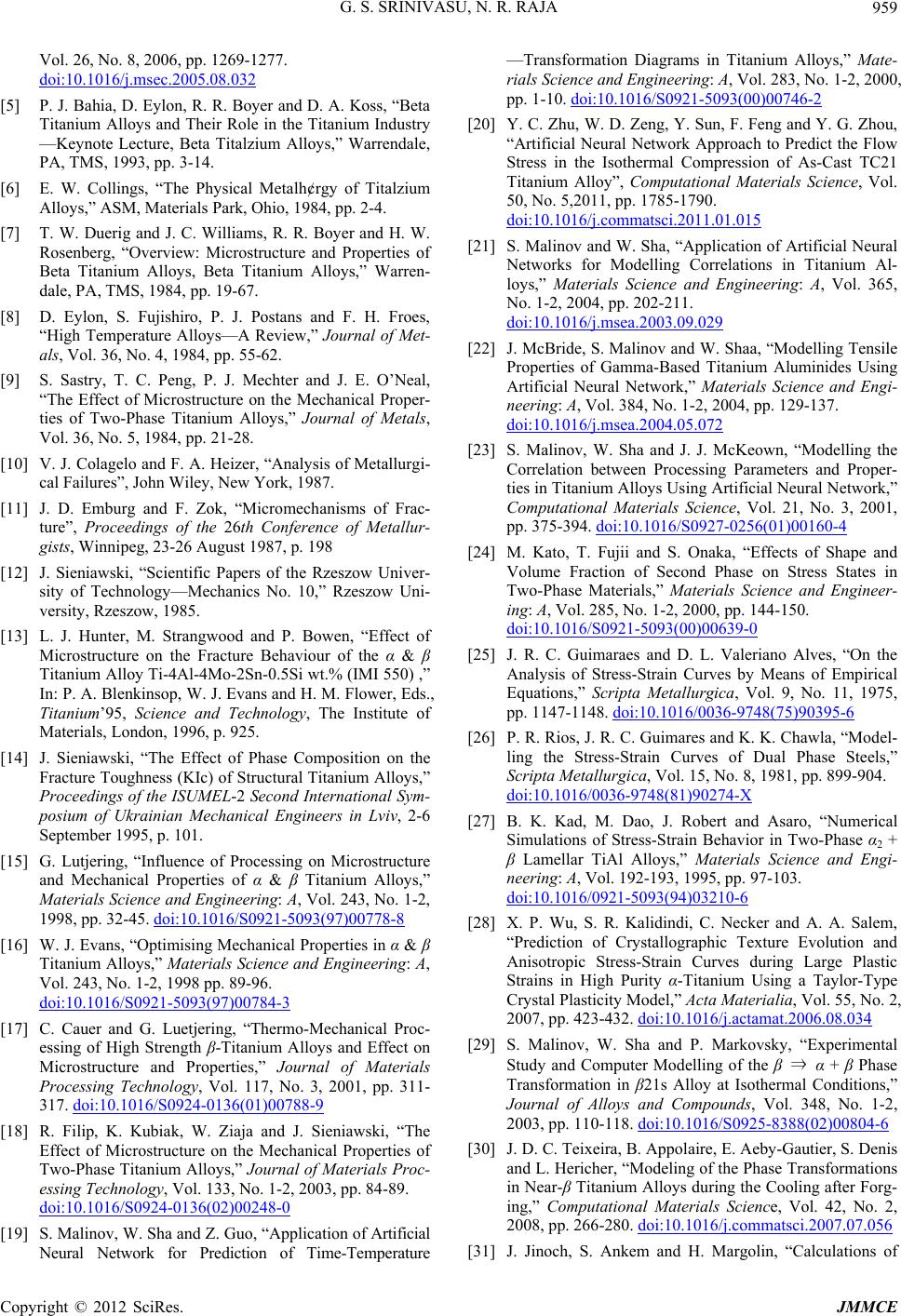
G. S. SRINIVASU, N. R. RAJA 959
Vol. 26, No. 8, 2006, pp. 1269-1277.
doi:10.1016/j.msec.2005.08.032
[5] P. J. Bahia, D. Eylon, R. R. Boyer and D. A. Koss, “Beta
Titanium Alloys and Their Role in the Titanium Industry
—Keynote Lecture, Beta Titalzium Alloys,” Warrendale,
PA, TMS, 1993, pp. 3-14.
[6] E. W. Collings, “The Physical Metalh¢rgy of Titalzium
Alloys,” ASM, Materials Park, Ohio, 1984, pp. 2-4.
[7] T. W. Duerig and J. C. Williams, R. R. Boyer and H. W.
Rosenberg, “Overview: Microstructure and Properties of
Beta Titanium Alloys, Beta Titanium Alloys,” Warren-
dale, PA, TMS, 1984, pp. 19-67.
[8] D. Eylon, S. Fujishiro, P. J. Postans and F. H. Froes,
“High Temperature Alloys—A Review,” Journal of Met-
als, Vol. 36, No. 4, 1984, pp. 55-62.
[9] S. Sastry, T. C. Peng, P. J. Mechter and J. E. O’Neal,
“The Effect of Microstructure on the Mechanical Proper-
ties of Two-Phase Titanium Alloys,” Journal of Metals,
Vol. 36, No. 5, 1984, pp. 21-28.
[10] V. J. Colagelo and F. A. Heizer, “Analysis of Metallurgi-
cal Failures”, John Wiley, New York, 1987.
[11] J. D. Emburg and F. Zok, “Micromechanisms of Frac-
ture”, Proceedings of the 26th Conference of Metallur-
gists, Winnipeg, 23-26 August 1987, p. 198
[12] J. Sieniawski, “Scientific Papers of the Rzeszow Univer-
sity of Technology—Mechanics No. 10,” Rzeszow Uni-
versity, Rzeszow, 1985.
[13] L. J. Hunter, M. Strangwood and P. Bowen, “Effect of
Microstructure on the Fracture Behaviour of the α & β
Titanium Alloy Ti-4Al-4Mo-2Sn-0.5Si wt.% (IMI 550) ,”
In: P. A. Blenkinsop, W. J. Evans and H. M. Flower, Eds.,
Titanium’95, Science and Technology, The Institute of
Materials, London, 1996, p. 925.
[14] J. Sieniawski, “The Effect of Phase Composition on the
Fracture Toughness (KIc) of Structural Titanium Alloys,”
Proceedings of the ISUMEL-2 Second International Sym-
posium of Ukrainian Mechanical Engineers in Lviv, 2-6
September 1995, p. 101.
[15] G. Lutjering, “Influence of Processing on Microstructure
and Mechanical Properties of α & β Titanium Alloys,”
Materials Science and Engineering: A, Vol. 243, No. 1-2,
1998, pp. 32-45. doi:10.1016/S0921-5093(97)00778-8
[16] W. J. Evans, “Optimising Mechanical Properties in α & β
Titanium Alloys,” Materials Science and Engineering: A,
Vol. 243, No. 1-2, 1998 pp. 89-96.
doi:10.1016/S0921-5093(97)00784-3
[17] C. Cauer and G. Luetjering, “Thermo-Mechanical Proc-
essing of High Strength β-Titanium Alloys and Effect on
Microstructure and Properties,” Journal of Materials
Processing Technology, Vol. 117, No. 3, 2001, pp. 311-
317. doi:10.1016/S0924-0136(01)00788-9
[18] R. Filip, K. Kubiak, W. Ziaja and J. Sieniawski, “The
Effect of Microstructure on the Mechanical Properties of
Two-Phase Titanium Alloys,” Journal of Materials Proc-
essing Technology, Vol. 133, No. 1-2, 2003, pp. 84-89.
doi:10.1016/S0924-0136(02)00248-0
[19] S. Malinov, W. Sha and Z. Guo, “Application of Artificial
Neural Network for Prediction of Time-Temperature
—Transformation Diagrams in Titanium Alloys,” Mate-
rials Science and Engineering: A, Vol. 283, No. 1-2, 2000,
pp. 1-10. doi:10.1016/S0921-5093(00)00746-2
[20] Y. C. Zhu, W. D. Zeng, Y. Sun, F. Feng and Y. G. Zhou,
“Artificial Neural Network Approach to Predict the Flow
Stress in the Isothermal Compression of As-Cast TC21
Titanium Alloy”, Computational Materials Science, Vol.
50, No. 5,2011, pp. 1785-1790.
doi:10.1016/j.commatsci.2011.01.015
[21] S. Malinov and W. Sha, “Application of Artificial Neural
Networks for Modelling Correlations in Titanium Al-
loys,” Materials Science and Engineering: A, Vol. 365,
No. 1-2, 2004, pp. 202-211.
doi:10.1016/j.msea.2003.09.029
[22] J. McBride, S. Malinov and W. Shaa, “Modelling Tensile
Properties of Gamma-Based Titanium Aluminides Using
Artificial Neural Network,” Materials Science and Engi-
neering: A, Vol. 384, No. 1-2, 2004, pp. 129-137.
doi:10.1016/j.msea.2004.05.072
[23] S. Malinov, W. Sha and J. J. McKeown, “Modelling the
Correlation between Processing Parameters and Proper-
ties in Titanium Alloys Using Artificial Neural Network,”
Computational Materials Science, Vol. 21, No. 3, 2001,
pp. 375-394. doi:10.1016/S0927-0256(01)00160-4
[24] M. Kato, T. Fujii and S. Onaka, “Effects of Shape and
Volume Fraction of Second Phase on Stress States in
Two-Phase Materials,” Materials Science and Engineer-
ing: A, Vol. 285, No. 1-2, 2000, pp. 144-150.
doi:10.1016/S0921-5093(00)00639-0
[25] J. R. C. Guimaraes and D. L. Valeriano Alves, “On the
Analysis of Stress-Strain Curves by Means of Empirical
Equations,” Scripta Metallurgica, Vol. 9, No. 11, 1975,
pp. 1147-1148. doi:10.1016/0036-9748(75)90395-6
[26] P. R. Rios, J. R. C. Guimares and K. K. Chawla, “Model-
ling the Stress-Strain Curves of Dual Phase Steels,”
Scripta Metallurgica, Vol. 15, No. 8, 1981, pp. 899-904.
doi:10.1016/0036-9748(81)90274-X
[27] B. K. Kad, M. Dao, J. Robert and Asaro, “Numerical
Simulations of Stress-Strain Behavior in Two-Phase α2 +
β Lamellar TiAl Alloys,” Materials Science and Engi-
neering: A, Vol. 192-193, 1995, pp. 97-103.
doi:10.1016/0921-5093(94)03210-6
[28] X. P. Wu, S. R. Kalidindi, C. Necker and A. A. Salem,
“Prediction of Crystallographic Texture Evolution and
Anisotropic Stress-Strain Curves during Large Plastic
Strains in High Purity α-Titanium Using a Taylor-Type
Crystal Plasticity Model,” Acta Materialia, Vol. 55, No. 2,
2007, pp. 423-432. doi:10.1016/j.actamat.2006.08.034
[29] S. Malinov, W. Sha and P. Markovsky, “Experimental
Study and Computer Modelling of the β ⇒ α + β Phase
Transformation in β21s Alloy at Isothermal Conditions,”
Journal of Alloys and Compounds, Vol. 348, No. 1-2,
2003, pp. 110-118. doi:10.1016/S0925-8388(02)00804-6
[30] J. D. C. Teixeira, B. Appolaire, E. Aeby-Gautier, S. Denis
and L. Hericher, “Modeling of the Phase Transformations
in Near-β Titanium Alloys during the Cooling after Forg-
ing,” Computational Materials Science, Vol. 42, No. 2,
2008, pp. 266-280. doi:10.1016/j.commatsci.2007.07.056
[31] J. Jinoch, S. Ankem and H. Margolin, “Calculations of
Copyright © 2012 SciRes. JMMCE